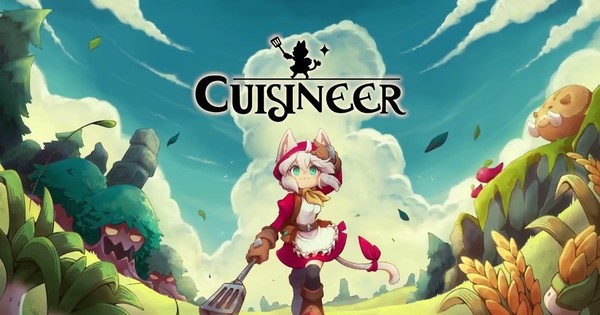Curated From www.animenewsnetwork.com Check Them Out For More Content.
Cuisineer is a delightful title that blends several disparate elements in ways both fresh and familiar, all in an affordable and adorable package. You’ll recognize a lot of mechanics in Cuisineer from other titles, though I think the blend is a rather unique concoction on its own.
I have to admit I was apprehensive going into this review. Reading the summary of the game’s elements was overwhelming: roguelite, action-adventure, dungeon crawler, restaurant management, life sim. I couldn’t tell if this was just a grab-bag of search tags or if there was a cohesive vision for a game within the laundry list of items. But it wasn’t that different from reading an ingredients list before I’d begun cooking. With a bit of time and step-by-step instruction, the disparate parts begin to coalesce into a rather appetizing treat.
By my reckoning, there are three pillars to the Cuisineer formula: dungeon crawling, restaurant management, and the aesthetics/vibe. What surprised me was which elements clicked with me most, given my usual preferences. Let’s take them in turn.
The dungeon crawling is where you head out as Pom to tackle various themed dungeons. Each dungeon is broken up into levels, and the enemies grow more challenging as you descend while the potential resources grow more rare—typical dungeon fare. Each floor of the dungeon is procedurally generated each time you enter, meaning you can never get too comfortable with what a potential dungeon floor may contain. The moment-to-moment gameplay reminds me of something like Hades—the isometric perspective, ability cooldowns, and quick dash mechanic had me piloting Pom in the same way I had Zagreus in times past.
However, the primary aim of dungeon crawling is not about acquiring relics or weapon upgrades per se. It is more akin to something like Moonlighter, where you’re harvesting stacks of resources and trying to decide whether to push your luck or head back home to use your loot. Death is only a minor setback, as Pom will retain her cooking ingredients on death but not her construction materials, so depending on your aim for a given delve, you might decide to go for it regardless.
The restaurant management aspect is more management sim than cooking sim. Once you open your restaurant, customers will begin to filter in and look for certain meals. Assuming there is enough seating and you have the right ingredients in your store stash, they will sit down and order a meal. Prepping it for them is a simple matter of running over to the appropriate station and clicking cook, after which a timer will begin. Soon enough, the finished food appears on a counter, which they retrieve and then eat independently. Once done, they’ll go to pay but will wait for you to collect the money.
In the early hours, this primarily results in you pinging back and forth between needed locations. Rush to the kitchen to prep the food, then to the counter to take the money. Eventually, things will die down enough for you to catch a breather and count the day’s profits. The money can help upgrade your shop, purchase new equipment or seating arrangements, upgrade your adventuring gear, and more.
To accomplish those tasks, you’ll need to explore Paell and meet its various citizens. These anthropomorphic friends are an eclectic bunch whose personality shines through despite the lack of voice acting in the game. You purchase upgrades, take side quests from them, receive gifts on special days, and, all in all, take in the simple joys of the adorable town. There’s always something to do, something to buy, something to craft, and something just out of reach regarding your current resources.
This all sets up a very satisfying game loop. Head to the dungeon to get ingredients and supplies. Open the restaurant to make meals and earn money. Use the money and supplies to upgrade or expand your restaurant. Batter Lather, rinse, repeat. The loop is obvious but no less intoxicating for its openness.
I found it all engaging, though not quite in the areas I anticipated.
Much to my surprise, I loved the restaurant management aspect. I think I expected a more in-depth cooking simulation—something akin to Cooking Mama or even Lemon Cake (a game my wife enjoys). But the game flow reminds me more of something like Diner Dash or other macro-level sim games where the specifics are automated, but you have to use your limited attention to make sure everything keeps flowing properly. Once that sign flipped to OPEN and the customers started coming in, I fell into a steady rhythm of preparation, cleanup, and cash-outs. Watching the little coin counter climb up and up is a bit too satisfying, if I’m being honest.
The aesthetics and vibe were also quite welcome. This is a game I would describe as cozy, with its comforting colors, low stakes, and darling characters. I had a big smile every time I saw Pom’s relieved face when the dinner rush was done or when the charming townsfolk popped in to regale me with their stories. For a game about debt and abandonment that propels you into a life of solo mercenary chicken-slaying, it does a great job of never making you feel too alone or overwhelmed. Even death in the dungeon is more defeat than anything, and it doesn’t stop you from coming home, brushing yourself off, and opening up for the breakfast crowd.
The combat is where I bounced off the game more than I expected. I am already somewhat middling on action-roguelikes (I much prefer turn-based, so I can carefully consider each choice, each relic, etc.), but I think the aesthetic choices hold it back in this space. Many enemies blend in with the environment too much for my liking. Combined with the small size of many of the enemies and their surprising speed, it felt like I was never clear on who or what I was fighting and just mashed and dashed my way through danger. Many of the enemy designs I encountered also felt a bit too adorable and samey to distinguish; sure, some of the tiny blobs looked like chickens, but it was hard to tell the other tiny blobs apart at times.
The lack of health bar displays also made me feel disconnected from the combat. I know it’s a simple thing, but the lack of health bars made it less obvious how close or far I was from victory in certain fights. This may have been more realistic—well, as realistic as using a battle spatula to fight sentient fire-breathing peppers can be—but it removed some of the tension from the fights because there was no sense of “If I can just hang in a bit longer!” When added in with the high numbers of high speed, tiny, indistinguishable enemies, and most combats blurred together and not in the feel-good way the restaurant aspects did.
Honestly, these are relatively minor complaints, given the quality that is present. Even in the tens of hours played, I can tell I’ve barely scratched the surface of what there is to do. I still have more recipes to unlock, more add-ons to make to my store, more dungeons to explore, more character details to find—there’s a hefty amount of game here.
Performance is also a massive plus for this game. I tested it both on my desktop and my Steam Deck (without any need to fiddle with the settings on either), and on both platforms, it ran like a dream. I never experienced a single crash in my time with the game, which is more than I can say for many supposed triple-A titles I’ve played recently. I have a few framerate drops now and then on Steam Deck, but it was only in the expected high-octane moments where lots of enemies and effects were popping off at once.
And all of this for an incredibly affordable price, too. The game runs $24.99 (or your regional equivalent) at launch. There is a deluxe edition, too, with soundtracks and artbook, as is the norm these days. That said, a feature-complete game with tight controls, excellent performance, and an addicting gameplay loop for that price strikes me as a good deal.
Though not within its minor gripes, Cuisineer is many games in one very affordable package. Its unique blend of familiar elements makes for a great time that will appeal to just about anyone who finds its aesthetic and theme exciting at first blush. Now, if you’ll excuse me, I’ve got hungry customers waiting…

